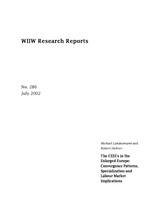The CEECs in the Enlarged Europe: Convergence Patterns, Specialization and Labour Market Implications
Michael Landesmann and Robert Stehrer
wiiw Research Report No. 286, July 2002
51 pages including 13 Tables and 14 Figures
This paper discusses the evolution of competitiveness, industrial and trade specialization of the countries of Central and Eastern Europe (CEECs). It is shown that the paths taken by the different CEECs have been quite diverse and we attempt to show that a combination of a catching-up plus trade specialization model is required to understand the patterns of specialization emerging in Central and Eastern Europe. We start with a description of the main features of macro-structural change and move on to discuss patterns of productivity and wage catching-up across industries which give rise to interesting movements in comparative cost dynamics. This is complemented with an analysis of patterns of trade specialization, including measures of product quality upgrading. We add information about the industrial allocation of FDI and comparative educational attainment as well as on the evolution of labour demand by skill groups. All the above yields an interesting (and at times unexpected) picture of the evolving division of labour in an enlarged Europe.
Keywords: structural change, international specialization, catching-up, convergence, Central and Eastern Europe, EU enlargement, international integration and labour markets
JEL classification: F02, F14, F21, L6, O57, P52
Countries covered: Czechia, Hungary, Poland, Slovakia, Slovenia, Visegrad countries
Research Areas: Labour, Migration and Income Distribution, International Trade, Competitiveness and FDI, Sectoral studies
